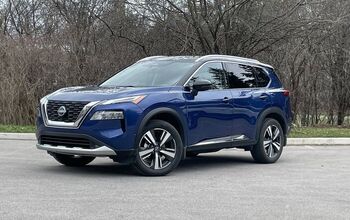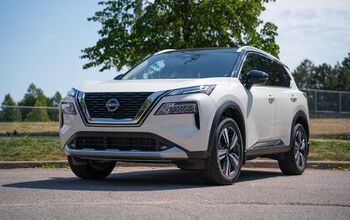2024 Nissan Rogue Platinum Review: Quiet Confidence

It was a tough act to follow.
This fully loaded 2024 Nissan Rogue Platinum came to me immediately after the Porsche 718 Spyder RS. That stripped-out race car for the road was one of my standouts for the year, perfectly tailored to deliver on its mission statement: driver enjoyment.
In an odd way, the Rogue is similar, built precisely for a specific job. Nissan’s top-selling model is not the most engaging nor adventurous choice in the segment, but it blends into the daily grind like it was made for it.
2024 Nissan Rogue Platinum Quick Take
Not sporty nor rugged, the Nissan Rogue is laser-focused on best doing what most people need of a small SUV: defeating the daily grind in comfort.
What's New for 2024:
The Rogue saw a subtle facelift for the year, with tweaked styling that consisted of new fascias front and back as well as updated wheel designs. A tech upgrade saw more kit trickle down into the middle trims as well. Both the SL and Platinum trims now feature a 12.3-inch touchscreen, which brings Google Built-In to the Rogue.
Exterior style:
The changes outside are imperceptible to all but the most fervent Rogue fan. (Those exist, right?) It’s more honest, if anything: the faux skid plate of yesteryear is now just two vestigial trim bits along the flanking the lower air intake. A redone grille keeps the V-shape but does it in a more elegant way. There’s less brightwork out back too, along with Nissan says are tweaked taillights but which look all but identical to us. The wheelarches are now glossy instead of matte black, and wrap around multi-spoke, machined 19-inch alloys. It’s a handsome enough thing, this Rogue.
2024 Nissan Rogue Platinum Review: All the Details
Powertrain and fuel economy:
Nissan’s little turbocharged three-cylinder boasts impressive numbers. With 201 horsepower and 225 pound-feet of torque, it’s amongst the strongest standard engines in the class. Continuously variable transmissions have got flack in the past, including Nissan’s units, but this one is a good match. It’s responsive without being jumpy, and the low-down turbo torque means it doesn’t need to hold revs high to get work done. Progress is smooth, and the Rogue gets up to merging speed without issue.
This variable compression engine is very complex: to simplify, it uses this tech to provide both better power and better fuel economy. Officially, the Rogue Platinum will do 28 mpg city and 34 mpg highway (8.4 and 6.8 L/100 km, respectively). Base and SV trims do very slightly better on the highway due to smaller wheels. We’ve seen better in prior tests, but this model did a whole lot of city driving in November weather, pushing the combined figure to 26 mpg (9.0 L/100 km).
It’s important to note that last year the NHTSA opened a probe into this family of engines, per Reuters. This was based on six cases, three of which were Rogues with the KR15DDT engine found here.
Handling and drivability:
The Rogue doesn’t pretend to be sporty. That’s fine by me: too few vehicles do that these days, and this isn’t the segment nor target audience where it’s necessary. The steering is light and accurate, and the Rogue responds to inputs consistently with little tilt or sway. The SUV is well-planted and confident on the highway, where it’s likely to spend lots of time.
Ride quality and comfort:
While the Rogue is best when relaxed, the reality is it still rides on large 19-inch alloy wheels. This does introduce a harsher edge to bumps and rough surfaces. Thankfully there is plenty of sound insulation throughout this top-spec Platinum, so bumps are felt but rarely heard.
Nissan’s front seats remain some of the best in the segment: comfortable but oh-so supportive for those longer trips. Leather shows up on the mid-level SL and is quilted here in the Platinum. There is seat heating front and rear, though no option for ventilation which is becoming increasingly common in the segment.
Back-seat space is average: headroom is 37.8 inches (960 millimeters) while legroom is 38.5 inches (978 mm). There’s good amounts of light thanks to the tall windows and large panoramic roof however, and easy access with doors that open almost a full 90 degrees. Too much light? Manual sunshades take care of that.
Cargo space is also only okay, with 36.3 cubic feet (1,033 liters) of storage behind the rear seats. The Rogue makes the most of it however: SL and Platinum trims come with a moveable floor panel that can be adjusted to hide smaller items or even stowed vertically to partition the cargo hold.
Interior style and quality:
Nissan put a big focus on interior quality with this generation of Rogue and it pays off. The Rogue’s cabin looks and feels good, with soft-touch materials right in high-traffic areas. The dashboard design is clean and there are plenty of easy-to-use controls centered in the lower section. We do prefer the cabin scheme with actual colors instead of all this black, mind you. There’s no guesswork needed here: just get in and go.
If there is a quibble to be had, it’s with the electronic shifter. It wiggles around more than expected, a small hit to the overall sense of quality within the Rogue. It’s also annoyingly hard to get into neutral.
Tech and safety:
The big news here is that new Google Built-In screen. At 12.3 inches across it is big and easy to read, with a slick interface that finds a balance between aesthetic and practical needs. The new setup allows users to integrate their Google profiles and all the associated bits right in the car itself—but no worries, wireless Apple CarPlay and Android Auto are both still here. A wireless charger is expected on a top-trim model these days, but it’s nice to know the Rogue SL also benefits.
There’s a good stock of tech and safety kit here as well, including a head-up display, 360-degree camera, and a solid 10-speaker Bose sound system. Nissan includes all the usual driver assists on all trims: the Platinum adds parking sonar, ProPilot Assist 1.1, and the afore-mentioned surround view camera. For 2025 ProPilot 2.1, which includes the capability for hands-free driving on highways, is optional.
Value, dollars, and sense:
In America, the 2024 Nissan Rogue lineup kicks off with the $30,240 front-drive S model. The SV sits above that for roughly $1,700 more, then the $37,090 SL, and the top Platinum at $40,520. All prices include destination. All-wheel drive is an additional $1,500 on all trims. In America, the motion-activated liftgate, tri-zone climate controls, rear sunshades and heated seats, and HUD included here are part of a $990 Platinum Premium package.
All-wheel drive is standard in Canada, where the Rogue S lists for $35,678 CAD. The SV is a big jump to $39,628 CAD, followed by the $44,928 CAD SL and this $47,823 CAD Platinum.
Final thoughts: 2024 Nissan Rogue Platinum Review
The 2024 Nissan Rogue remains an easy compact SUV to like. It doesn’t have a hybrid— yet—but when it does get one, that will further sweeten the deal as well as likely sidestep any concerns about that engine probe. As is, it scores well across the board, and its honesty as a daily driver is appreciated.
Become an AutoGuide insider. Get the latest from the automotive world first by subscribing to our newsletter here.
Category | Vehicle Name |
Powertrain | 8 / 10 |
Efficiency | 8 / 10 |
Handling and Drivability | 7 / 10 |
Passenger Comfort | 8 / 10 |
Ride Quality | 4 / 5 |
Exterior Style | 3 / 5 |
Interior Style and Quality | 8 / 10 |
Infotainment | 8 / 10 |
Cargo Capacity and Towing | 4 / 5 |
Safety | 4 / 5 |
Value | 8 / 10 |
Emotional Appeal | 7 / 10 |
TOTAL | 77 / 100 |
Specifications | 2024 Nissan Rogue Platinum |
|---|---|
Engine: | 1.5L I4 Turbo |
Outputs: | 201 hp, 225 lb-ft |
Drivetrain: | AWD |
Transmission: | CVT |
US Fuel Economy (mpg): | 28/34/31 |
CAN Fuel Economy (L/100 km): | 8.4/6.8/7.7 |
Starting Price (USD): | $30,240 (inc. dest.) |
As-Tested Price (USD): | $41,860 (inc. dest.) |
Starting Price (CAD): | $35,678 (inc. dest.) |
As-Tested Price (CAD): | $47,823 (inc. dest.) |
Pros | Cons |
|---|---|
Quality cabin | Complicated engine |
Lots of features | Stiff ride |
No sporty pretences | Average rear seat and cargo space |

Kyle began his automotive obsession before he even started school, courtesy of a remote control Porsche and various LEGO sets. He later studied advertising and graphic design at Humber College, which led him to writing about cars (both real and digital). He is now a proud member of the Automobile Journalists Association of Canada (AJAC), where he was the Journalist of the Year runner-up for 2021.
More by Kyle Patrick









































Comments
Join the conversation